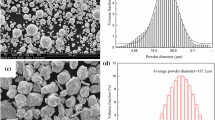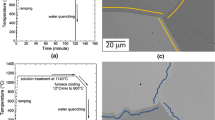Abstract
Directionally solidified (DS) and oxide dispersion strengthened (ODS) superalloys like CM 247 LC and MA 760 exhibit elongated macrograins. In uniaxial creep tests, the creep strength of such alloys in the direction of the longitudinal grains is higher than that of an equiaxed grain structure, because significantly less grain boundary (GB) segments are perpendicular to the axis of the applied stress. The present study investigates how creep in the longitudinal direction of these alloys is influenced (1) by deviations of individual grain orientations from the optimum growth direction during casting (CM 247 LC) and (2) by the spatial distribution of the small transverse GB segments (MA 760) for a given grain aspect ratio. In the case of creep ductile CM 247 LC, it was shown that if there is a large fraction of grains that are oriented for single slip, this results in higher creep rates and lower rupture times than if there is only a small fraction of such grains. The study of the influence of grain morphology on creep damage accumulation in the creep-brittle and notch-sensitive ODS alloy MA 760 showed that large scatter in creep rupture lives is related to (1) the stochastic nature of creep damage accumulation on transverse GB segments and (2) the spatial distribution of transverse GB segments. It is the combination of these two factors that results in increased scatter in rupture lives as compared to equiaxed fine grain structures.
Similar content being viewed by others
References
F.L. Versnyder and M.E. Shank:Mater. Sci. Eng., 1970, vol. 6, pp. 213–47.
M. McLean:Directionally Solidified Materials for High Temperature Service, The Metals Society, London, 1983.
G.H. Gessinger:Powder Metallurgy of Superalloys, Butterworth and Co., London, 1984.
P. Jongenburger: Ph.D. Thesis, Ecole Polytechnique Fédérale de Lausanne, Lausanne, Switzerland, 1988.
J.J. Stephens: Ph.D. Thesis, Stanford University, 1984.
P.N. Quested and S. Osgerby:Mater. Sci. Technol., 1986, vol. 2, pp. 461–75.
E. Arzt and R.F. Singer:Superalloys 1984, Proc. 5th Int. Symp. on Superalloys, Oct. 7–11, 1984, Seven Springs Mountain Resort, Champion, PA, M. Gell, C.S. Kortovich, R.H. Bricknell, W.B. Kent, and J.F. Radavich, TMS-AIME, Warrendale, PA, 1984.
B. deMestral and G. Eggeler:Prac. Metallogr., 1992, vol. 29, pp. 174–91.
H.J. Bunge:International Materials Reviews, 1987, vol. 32, pp. 265–91.
B. deMestral and G. Eggeler: Swiss Federal Institute of Technology, Lausanne, Switzerland, unpublished work, 1992.
G. Jakobi: Diploma Thesis, Ecole Polytechnique Fédérale de Lausanne, Lausanne, Switzerland, 1991.
B. deMestral, N. Merk, G. Eggeler: Final report of COST 501/II/WP5A, Ecole Polytechnique Fédérale de Lausanne, Lausanne, Switzerland, 1993.
Gerald R. Leverant, Bernard H. Kear:Metall. Trans., 1970, vol. 1, pp. 491–98.
G.R. Leverant, B.H. Kear, and J.M. Oblak:Metall. Trans., 1973, vol. 4, pp. 355–62.
H. Riedel:Rupture at High Temperatures, Springer-Verlag, Berlin, 1987.
G.J.S. Higginbotham:Mater. Sci. Technol., 1986, vol. 2, pp. 442–60.
R.A. MacKay and R.D. Maier:Metall. Trans. A, 1982, vol. 13A, pp. 1747–54.
E. Schmid and W. Boas:Plasticity of Crystals, Hughes, London, 1950.
V. Guttmann and H. Fattori: Commission of the European Communities, Joint Research Centre Petten, unpublished results obtained within COST 501/II/WP1 (project CCR1), personal communication, 1992.
N. Nilsvang and G. Eggeler:Pract. Metallogr., 1987, vol. 24, pp. 323–35.
G. Eggeler, J.C. Earthman, N. Nilsvang, and B. Ilschner:Acta Metall., 1989, vol. 37, pp. 49–60.
G. Eggeler:Acta Metall. Mater., 1991, vol. 89, pp. 221–31.
M. Cans, B. deMestral, and G. Eggeler:Scripta Metall. Mater., 1994, vol. 30, pp. 107–12.
Author information
Authors and Affiliations
Additional information
This article is based on a presentation made at the “High Temperature Fracture Mechanisms in Advanced Materials” symposium as part of the 1994 Fall meeting of TMS, October 2-6, 1994, in Rosemont, Illinois, under the auspices of the ASM/SMD Flow and Fracture Committee.
Rights and permissions
About this article
Cite this article
DeMestral, B., Eggeler, G. & Klam, H.J. On the influence of grain morphology on creep deformation and damage mechanisms in directionally solidified and oxide dispersion strengthened superalloys. Metall Mater Trans A 27, 879–890 (1996). https://doi.org/10.1007/BF02649755
Issue Date:
DOI: https://doi.org/10.1007/BF02649755




